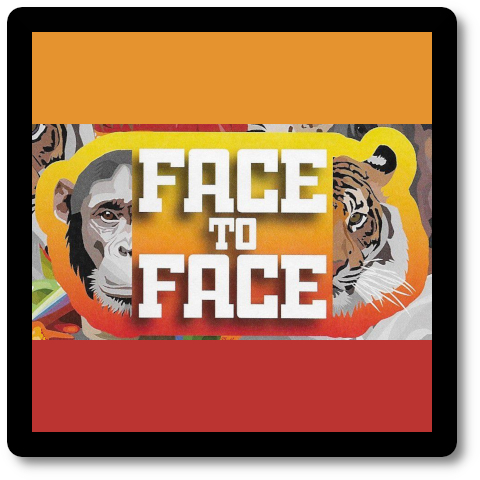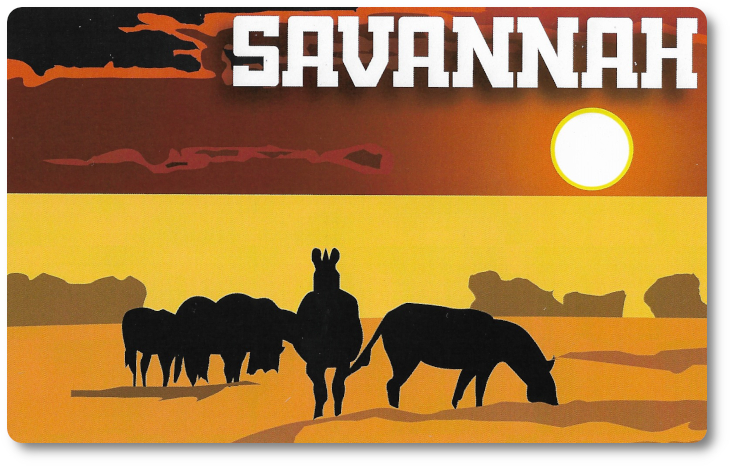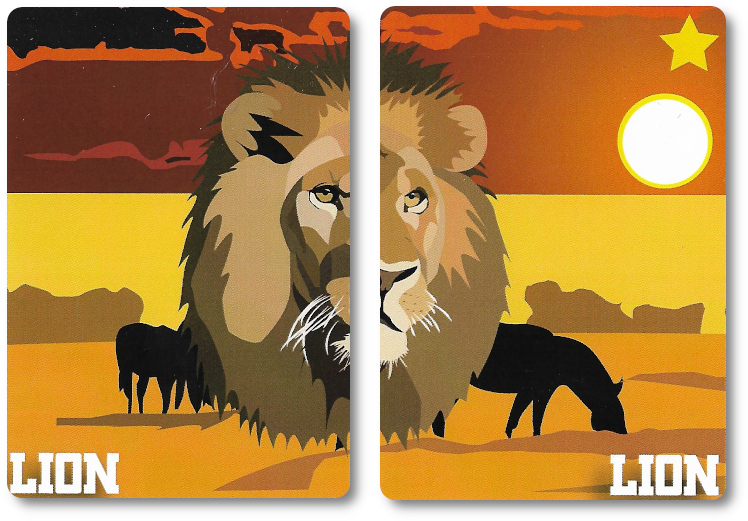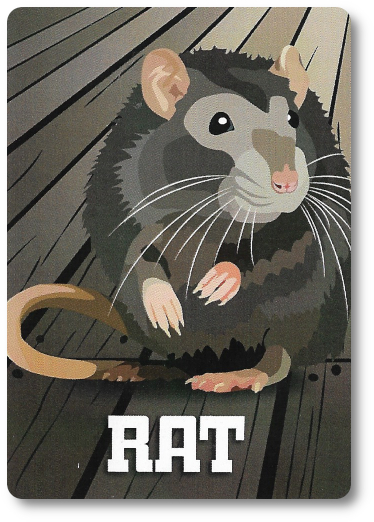Please Take Note: This is a review of the final game, but it might change slightly based on the success of the Kickstarter campaign. The game is being reviewed on the components and the rules provided with the understanding that “what you see is not what you might get” when the game is published. If you like what you read and want to learn more, we encourage you to visit the game’s web page and visit the Kickstarter campaign. Now that we have all that disclaimer junk out of the way, on with the review.

The Basics:
- For ages 4 and up
- For 2 to 4 players
- Approximately 30 minutes to complete
Geek Skills:
- Active Listening & Communication
- Counting & Math
- Logical & Critical Decision Making
- Reading
- Memorization & Pattern/Color Matching
- Hand/Resource Management
- Trading
Learning Curve:
- Child – Easy
- Adult – Easy
Theme & Narrative:
- Return the animals to their home
Endorsements:
- Gamer Geek rejected!
- Parent Geek approved!
- Child Geek approved!
Overview
English novelist, essayist, journalist and critic, George Orwell, said “All animals are equal, but some animals are more equal than others.” In this game, players will be rescuing animals and returning them to their homes, ensuring they are safe and sound. But as Mr. Orwell alluded to, not every animal is worth saving, nor are they of the same value. In the end, it will be up to the player to determine their worth.
Face to Face, designed by Aidan Blum and to be published by Mockingbird Games, will reportedly be comprised of 120 Face cards, 20 Place cards, and four Player Aid cards. As this is a review of a prepublished game, I cannot comment on the game component quality. Artwork by Mason Guttensohn is clean and stylized, giving the game a professional look.
Venture Into Nature
To set up the game, first separate the cards into a Face card pile and a Place card pile. Shuffle both piles separately to create the Face draw deck and the Place draw deck.
Second, deal one Place card and four Face cards to each player. These cards go into the player’s hand and should be kept secret until played. Note that the Place cards are twice as big as the Face cards. Having the different sized cards in your hand is going to feel awkward at first, but you get used to it quickly.
Third, place the draw decks face-down in the middle of the playing area and within easy reach of all the players.
That’s it for game set up. Determine who will be the first player and begin.
Animal Crossing
Face to Face is played in rounds and turns with no set number of rounds per game. On a player’s turn they can select two actions. Different actions can be taken in any order or the player can take the same action twice. The available actions are as follows.
Action One: Draw a Card
This action allows the player to draw one card from the Place or the Face draw deck. Players have a hand size limit of seven cards.
Action Two: Play a Card
This action allows the player to play cards from their hand.
The Place cards represent four different locations in the world (pasture, Savannah, jungle, and arctic). A played Place card is placed in front of the player, face-up.

The Face cards are placed to their matching Place cards (meaning, Face cards cannot be played before Place cards). To play a Face card the player must have a matching pair. Yes, players can only play one card per action, but in this case, they are playing two. This still counts as one action.

Each Place card can “hold” no more than two matching Face card pairs.
Action Three: Trade a Card
This action allows the player to ask a single opponent, several opponents, or all the opponents if they would be willing to trade Face and Place cards in their hand. All trades are voluntary and done out in the open. However, trade requests must be phrased without a lot of detail. For example, a player could not ask an opponent for the “left side of the horse Face card”, but they could ask for a “horse card”. When asking for a trade, the player also states what they are willing to trade for. For example, “I will trade you a monkey for a horse”.
Each trade counts as one action and only one card per trade is allowed.
The “Special” Face cards can never be traded. These cards provide special actions and rule changes for the player. They include a wild Face card, an extra action, stealing a card from an opponent, and pulling a card of the player’s choice from the discard piles.

The “Rat” Face card is a “Special” Face card representing one animal. I personally like the fact that the other animals in the game are bigger, and as a result, require two Face cards. Mostly done for the mechanics of the game and scoring, but a nice visual touch all the same. “Rat” Face cards are played to an opponent’s Place card. Once played, it remains and now reduces the total number of points the opponent can collect from that place. Because the “Rat” is an animal, the only two animals per place rule applies. This means a player cannot place the “Rat” Face card to a Place card that already has two matching Face card pairs.

Action Four: Discard a Card
This action allows the player to discard one Face or one Place card from their hand to the discard pile. Remember, the hand size limit for a player is seven cards.
Action Five: Pass
This action allows the player to skip an action. Do it once and the player has only one action left. Do it twice and the player’s turn is over.
Home Sweet Home
The game ends when a player scores ten or more points by the end of their turn or the last Face card is drawn from the Face draw deck. In either case, the final round is now triggered. All players get one final turn (making sure that all players have the same number of turns) to attempt to make as many points as possible. Points are then scored.
For every matching pair of Face cards played, the player earns points. Some Face cards have a colored star. If both the Face cards played in the pair have a gold star, the player earns three points. If both the Face cards played in the pair have a silver star, the player earns two points. If the played pair of Face cards has no stars or a mix of different stars, the player only earns one point. The wild “Special” Face card has no stars. The pairing of the wild card with any other Face card will only ever earn the player one point.
If the player has the “Rat” Face card, the player determines the number of points earned as normal, but the points earned reduce the player’s total. For example, if the player had a Face pair worth three points and the “Rat”, the player would reduce their total score by three points.
The player with the most points wins the game!
Game Variants
Face to Face is already an easy game to teach and easy to play, but the game does come with game variants that reduces the total amount time needed to play the game. For example, remove the hand size limit, allowing players to collect more cards and play pairs for more points. Players can also reduce the total number of points needed to trigger the endgame, thus bringing the game to a close much faster.
If playing with very young Child Geeks, you can turn Face to Face into a game of memory. Take all the Face cards from a single place, shuffle, and deal to the table face-down in four rows, six cards per row. Players then take turns flipping over one and then another card in hopes of making a match. If a match is made, the player collects the set. If not, the cards are flipped back face-down and the next player goes. This makes Face to Face, essentially, into the game Memory with the exception of earning points. Players still use the stars to score more than one point per collected pair. The player with the most points after the last pair is collected is the winner.
To learn more about Face to Face, visit the game’s web page and visit the Kickstarter campaign.
Final Word
 The Child Geeks enjoyed the game, finding it to be fast and fun, but the more advanced Child Geeks decided that the game was not as challenging as they would have liked. According to one such Child Geek, “I play big games all the time. This feels like a kids’ game to me. I’d rather play with miniatures, roll dice, and calculate movement.” Now, to be fair, this particular Child Geek was raised on such games as Risk instead of Candy Land, but the same sentiment was shared by other Child Geeks who have moved on to more complicated games. Not surprising, our youngest Child Geeks had problems with the Special cards, finding that they had to keep asking their brothers, sisters, and adults at the table to help them determine what the card meant. Here I think the designers made a misstep. They should have used simple icons to convey to the player the action the card provides. Instead, the player needs to be able to read. This slowed the game down, but did not ruin the game. According one of our younger Child Geeks, “I don’t mind asking for help as long as I get to play.” An excellent attitude, and while Face to Face was not liked by everyone, it was nevertheless enjoyed (to a point), resulting in the game being endorsed by the Child Geeks.
The Child Geeks enjoyed the game, finding it to be fast and fun, but the more advanced Child Geeks decided that the game was not as challenging as they would have liked. According to one such Child Geek, “I play big games all the time. This feels like a kids’ game to me. I’d rather play with miniatures, roll dice, and calculate movement.” Now, to be fair, this particular Child Geek was raised on such games as Risk instead of Candy Land, but the same sentiment was shared by other Child Geeks who have moved on to more complicated games. Not surprising, our youngest Child Geeks had problems with the Special cards, finding that they had to keep asking their brothers, sisters, and adults at the table to help them determine what the card meant. Here I think the designers made a misstep. They should have used simple icons to convey to the player the action the card provides. Instead, the player needs to be able to read. This slowed the game down, but did not ruin the game. According one of our younger Child Geeks, “I don’t mind asking for help as long as I get to play.” An excellent attitude, and while Face to Face was not liked by everyone, it was nevertheless enjoyed (to a point), resulting in the game being endorsed by the Child Geeks.
 The Parent Geeks found that Face to Face was not a game they would want to play with adults, but found it to be a wonderful game to play with their family. According to one Parent Geek, “I like animal games and I like how this one uses animals with fun game play. You have to put some thought into your cards and what cards you want to hold. You do have to think if you want to win.” This is especially true when playing against someone who is taking the time to match stars for extra points, putting more emphasis on hand management for big points rather than just blind set collecting. Another Parent Geek said, “A great game for the family and a great game for a mixed group of players. I can see this getting to the table at the cabin and during the holidays.” When all the animals had been returned to their homes, the Parent Geeks voted to approve Face to Face.
The Parent Geeks found that Face to Face was not a game they would want to play with adults, but found it to be a wonderful game to play with their family. According to one Parent Geek, “I like animal games and I like how this one uses animals with fun game play. You have to put some thought into your cards and what cards you want to hold. You do have to think if you want to win.” This is especially true when playing against someone who is taking the time to match stars for extra points, putting more emphasis on hand management for big points rather than just blind set collecting. Another Parent Geek said, “A great game for the family and a great game for a mixed group of players. I can see this getting to the table at the cabin and during the holidays.” When all the animals had been returned to their homes, the Parent Geeks voted to approve Face to Face.
 The Gamer Geeks acknowledged that the game designers put forth a good amount of effort to create a simple game that took some thought to win, but didn’t care for it. As gaming elitists, they found Face to Face lacked the depth of game play they hunger for and had little in the way of strategy and tactics. According to one Gamer Geek, “You win if you play points the fastest. I think a game should reward the smartest player, not the luckiest.” Another Gamer Geek said, “A great family game and fun for the kids, for certain, but for adults who play bigger and more complicated games? I think not.” All the Gamer Geeks gave it a go, both with their group and then with mixed groups. The results were always the same. “Good game for the kids”, resulting in the Gamer Geeks rejecting Face to Face.
The Gamer Geeks acknowledged that the game designers put forth a good amount of effort to create a simple game that took some thought to win, but didn’t care for it. As gaming elitists, they found Face to Face lacked the depth of game play they hunger for and had little in the way of strategy and tactics. According to one Gamer Geek, “You win if you play points the fastest. I think a game should reward the smartest player, not the luckiest.” Another Gamer Geek said, “A great family game and fun for the kids, for certain, but for adults who play bigger and more complicated games? I think not.” All the Gamer Geeks gave it a go, both with their group and then with mixed groups. The results were always the same. “Good game for the kids”, resulting in the Gamer Geeks rejecting Face to Face.
 This is a very simple game, but don’t let the simplicity of game play full you. For those players who want to be savvy about the way they go about the game, there is more to it than just playing cards. But not much. The trick is to collect cards that score the most points. But don’t take too long. The “Rat” card is a real pain. For those looking for a strategy that works, it’s best to play a Place card and then don’t play anything on it until you have enough Face cards to score two pairs. Extra points (literally) for matching the stars. It’s worthwhile to wait, which puts more emphasis on hand management.
This is a very simple game, but don’t let the simplicity of game play full you. For those players who want to be savvy about the way they go about the game, there is more to it than just playing cards. But not much. The trick is to collect cards that score the most points. But don’t take too long. The “Rat” card is a real pain. For those looking for a strategy that works, it’s best to play a Place card and then don’t play anything on it until you have enough Face cards to score two pairs. Extra points (literally) for matching the stars. It’s worthwhile to wait, which puts more emphasis on hand management.
Trading in this game is just an action and doesn’t do much other than announce to the table what you are looking for. Not a great tactic if you are trying to keep things hidden. Especially when you know there are rats about looking to reduce points (referring to the card here, not the player’s opponents). It’s better to discard and pass. The more info you give the other players, the weaker the player’s position in the game. We observed that players didn’t want to trade, as they always knew they were giving their opponent the card they needed.
Do not remove the hand size limit as the game variant suggests to make the game easier. It does, but it also makes the game a waste of your time. With the ability to have as many cards as you want in your hand, it reduces a lot of the subtle strategy to nothing and it makes the game feel longer, too. Players don’t play anything until they have what they need. Then, BAM, points start rolling in so fast that players don’t have time to react. Makes the game feel poorly designed, to be truthful. Avoid this game variant like the plague introduced by the rats.
For the family, Face to Face is a good time, especially for the younger Child Geeks. Expect to answer some questions when it comes to the Special cards if some of your players are not strong readers. You could remove the Special cards from the game (which we did), but it reduces the fun. Better to pause and help rather than attempt to streamline game play, reducing player interaction as a result. If you are looking for an animal game to play with your little animals, look no further than Face to Face.
This is a paid for review of the game’s final prototype. Although our time and focus was financially compensated, our words are our own. We’d need at least 10 million dollars before we started saying what other people wanted. Such is the statuesque and legendary integrity of Father Geek which cannot be bought except by those who own their own private islands and small countries.



